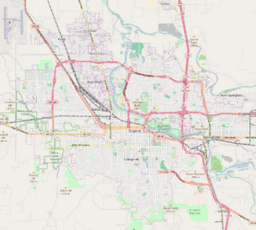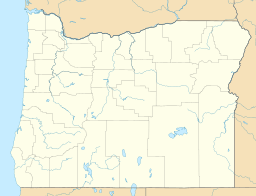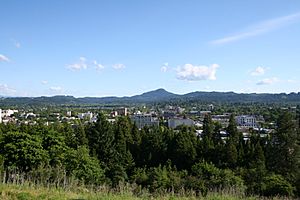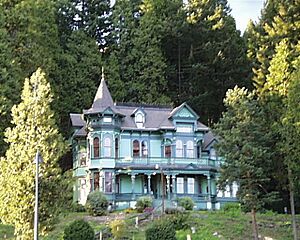Skinner Butte facts for kids
Quick facts for kids Skinner Butte |
|
|---|---|
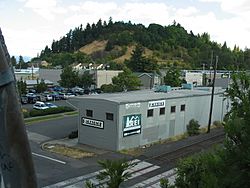
Skinner Butte from the west in 2006
|
|
| Highest point | |
| Geography | |
Skinner Butte is a well-known hill located on the northern edge of downtown Eugene, Oregon. It sits close to the Willamette River. This famous landmark is named after Eugene Skinner, who founded the city. It is also home to the Skinner Butte Park. In the early 1900s, some groups placed symbols on the butte, including a cross. These symbols were later removed or changed to represent the community better. The cross was finally taken down for good in 1997.
About Skinner Butte
Skinner Butte stands about 682 feet (208 m) above sea level. This means it is roughly 200 feet (60 m) higher than the city around it. A winding road goes all the way to the top. From there, you can see amazing views of Eugene. The public park on the butte has many hiking trails and open grassy areas.
You can also see a giant "O" symbol on the butte. This "O" stands for the University of Oregon. There used to be a less visible "Big E" for Eugene High School, which is now called South Eugene High School. These large letters were put up a long time ago, in the early 1900s.
The "O" used to be lit up before the big Civil War football game against Oregon State. In 2010, the Big "O" was added to the National Register of Historic Places. This means it is an important historical site. There is also a small water storage area on the eastern side of the butte, just below the top.
History of the Butte
The Kalapuya people lived in the Willamette Valley before settlers from Europe and America arrived. They called the butte "Ya-Po-Ah." In 1846, Eugene Skinner came to the valley. The Kalapuya people warned him about floods from the Willamette River. So, he built his cabin on the butte. This cabin became the start of his land claim. Today, a marker on the hillside shows where his cabin once stood. A copy of his cabin has been moved to different spots in the park over the years.
Skinner Butte Park officially opened in 1914. It has changed a lot since then. At one time, the park had a place for cars to camp. It also had a zoo. During the Great Depression, a camp for the Civilian Conservation Corps was located there.
The butte is a popular spot for many outdoor activities. People enjoy rock climbing on "The Columns." These are tall rock formations that were once part of a basalt quarry. The quarry operated from the 1890s to the 1930s. It is also a great place for birding. In July 2006, the City of Eugene opened a new playground called RiverPlay Discovery Village Playground in the park.
The Shelton-McMurphey-Johnson House is also on the butte. This beautiful Queen Anne Victorian home was built in 1880. The family who built it used to own the entire butte. Before trees grew tall and blocked the view, people called it the "Castle on the Hill." It was added to the National Register of Historic Places in 1984. The name "Ya-Po-Ah" is still used today. It is part of the name "Ya-Po-Ah Terrace." This is a tall building for older adults. It was built at the foot of the butte in 1968.
Images for kids


